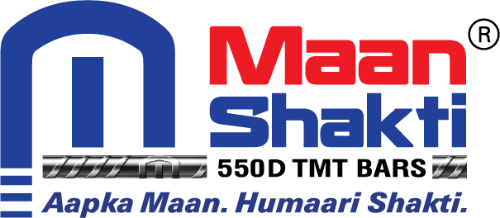In the realm of construction, the materials you choose can make all the difference in the durability of your structures. Among the various options available, 550D TMT (Thermo Mechanically Treated) steel bars have emerged as a go-to choice for projects that demand exceptional strength and flexibility. In this article, we will delve into the intricacies of 550D TMT bars, understanding what sets them apart and why they are preferred for critical infrastructure projects.
About the 550D TMT Steel Bar
The name “550D” signifies a specific grade of TMT steel bars, as defined by IS:1786, with “Fe” representing Iron, the primary component of these bars. The number “550” denotes the minimum yield stress in megapascals (MPa), which is the tensile stress required to produce a specific elongation. The letter “D” stands for ductility, indicating the capacity of the steel to deform without breaking.
In simpler terms, 550D TMT steel bars possess a higher percentage of tensile strength and elongation compared to lower-grade counterparts.
Applications of 550D TMT Steel Bars
Structures that require 550D TMT steel bars are those designed to bear heavy loads and withstand various challenges. These bars find their niche in a wide range of construction projects, including:
- Dams
- Railway Bridges
- Fly-Overs
- Skyscrapers
- Airports
- Industrial Structures
- Windmills
- Hospitals
- Tunnels
- Concrete Roads
The Importance of 550D TMT Steel Bars in Earthquake-Prone Areas
One of the standout features of 550D TMT steel bars is their exceptional resistance to seismic activity. This is crucial, especially in regions prone to earthquakes. The reduced levels of carbon, sulfur, and phosphorus in Fe550D TMT steel bars contribute to their seismic resistance. The unique TMT manufacturing process creates a steel product with a hard outer shield for strength and a soft inner core for flexibility, allowing the bars to withstand intense shaking during an earthquake.
Key Properties of 550D TMT Steel Bars
550D grade TMT bars are favoured for constructing critical infrastructure due to several key properties:
Earthquake Resistance: TMT bars are renowned for their seismic resistance, thanks to their soft pearlite core. They can withstand seismic and dynamic loading, making them ideal for construction in earthquake-prone areas. The high fatigue resistance of 550D TMT bars adds to their earthquake resilience.
High Elongation: TMT bars can elongate up to 50% more than their original length without compromising their integrity. This property is highly desirable in construction.
Corrosion and Rust Resistance: TMT bars exhibit excellent corrosion resistance, making them suitable for structures exposed to water and salinity, such as bridges, dams, canals, and sewage systems.
Flexibility and Bendability: TMT bars offer outstanding bending capabilities, allowing for the creation of intricate architectural designs and shapes.
Fire Resistance: Top-quality TMT bars, like the best TMT Bar in West Bengal, possess high thermal stability, withstanding temperatures ranging from 400 to 600°C. This quality ensures the safety of occupants in structures constructed with TMT steel bars.
Fatigue Resistance: TMT bars exhibit high fatigue resistance under dynamic loading due to the strong surface layer, enhancing their durability.
Weldability: TMT bars with low carbon equivalent content can be used for various weld joints without compromising strength.
Conclusion
550D TMT steel bars are the preferred choice for critical infrastructure projects and high-rise constructions due to their exceptional strength, flexibility, seismic resistance, and durability. Understanding the unique manufacturing process and key properties of these bars is essential for making informed decisions in construction projects where strength and stability are paramount. Choosing the right construction materials, such as 550D TMT steel bars, is a significant step toward constructing structures that are strong, durable, and stand the test of environmental challenges.


